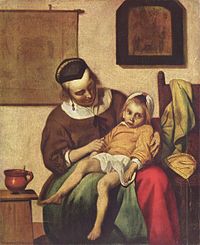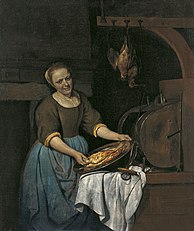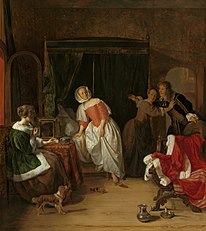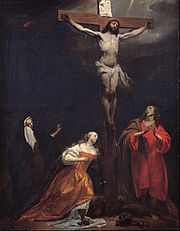Gabriël Metsu
Gabriël Metsu | |
|---|---|
 Gabriël Metsu self-portrait, with his wife, in an inn (1661) | |
| Born | 1629 |
| Died | Buried 24 October 1667 (aged 37–38) Amsterdam, Dutch Republic |
| Nationality | Dutch |
| Known for | Painting |
Gabriël Metsu (1629–1667) was a Dutch painter of history paintings, still lifes, portraits, and genre works. He was "a highly eclectic artist, who did not adhere to a consistent style, technique, or one type of subject for long periods".[1] Only 14 of his 133 works are dated.
Life
[edit]
Gabriel Metsu was the son of Jacques Metsu (c. 1588 – March 1629), a tapestry worker and painter originally from Hainault, who lived most of his days at Leiden,[2] and Jacquemijntje Garniers (c. 1590 – 8 September 1651), the widow of a painter with three children of her own.[3][4] It is not known when and where Gabriel was baptized; most likely in a Catholic hidden church but the baptismal records did not survive. Gabriel grew up on Lange Mare and his stepfather, a skipper, must have supported his education, because his mother was a poor midwife.
In 1648 Metsu was registered among the first members of the painters' guild at Leiden, but in 1650 he ceased to subscribe.[2] Metsu was possibly trained in Utrecht by the Catholic painters Nicolaus Knüpfer and Jan Weenix.[5]

Around 1655 Metsu moved to Amsterdam; he lived in an alley on Prinsengracht, next to a brewery and near his relatives, the children of the sugar refiner Philips Metsu.[6] In 1657 he got into an argument with a neighbor. (It was alleged that Metsu left a brothel at six in the morning.) Gabriel moved to a house on the canal side, where a daily vegetable market was held. In 1658 he married Isabella de Wolff,[7] whose father was a potter and mother the painter Maria de Grebber.
At the onset of the 1660s Metsu turned for inspiration to the art of the "fijnschilders" from his native Leiden. Metsu was responding to the market of Dou's paintings,[8] who sold his paintings all over for exorbitant prices. Metsu may have also influenced Pieter de Hooch.
For a while Metsu trained Michiel van Musscher and Joost van Geel. Metsu died at the age of 38 and was buried in the Nieuwe Kerk. Three bells were tolled; a habit in use with Dutch Catholics at that time. His widow left for Enkhuizen, to live with her mother. Isabella was buried in the Zuiderkerk in 1718.
Style and works
[edit]

According to Arnold Houbraken, Metsu was taught by Gerard Dou, though prior to about 1653 his influence is not apparent.[10][2] One of his earliest pictures is The Rich Man and Lazarus at the Strasbourg Museum, painted under the influence of Jan Steen. Under the influence of Rembrandt he produced the Woman taken in Adultery, (1653) a large picture in the Louvre. To the same period belong the Dismissal of Hagar, in the Museum De Lakenhal, Leiden, and the Widow's Mite at the Schwerin Gallery.[2]
Around 1653–1654, Metsu began placing his figures in domestic interiors and specialized in genre scenes on small panels. Old people were among Metsu's favorite thematic borrowings from Dou during his first years in Amsterdam.[11] Metsu often painted young (single) women who either fed pets,[12] sold goods at market (fruit, vegetables, fish, poultry, or meat), or were grocery-shopping themselves for these provisions.[13] Another significant painting from this period was The Vegetable Market in Amsterdam, in the Louvre, for which the Encyclopædia Britannica Eleventh Edition praised ", the characteristic movement and action of the dramatis personae, the selection of faces, the expression and the gesture, and the texture of the things depicted".[2]
Houbraken ends his biography with the comment that he was "of impeccable reputation", but he may have meant this ironically. Often, the subject of a Metsu painting was based on a popular emblem from an emblem book. This can give the painting a double meaning, such as in The Poultry seller, 1662, showing an old man offering a rooster to a young girl in a symbolic pose that is based on a lewd engraving by Gillis van Breen (1595–1622), with the same scene.[14] The accompanying verse is:
"Hoe duur dees vogel vogelaer?" "hy is vercocht" "waer?"
- How much for the bird, birdman? It's sold. Where?
"aen een waerdinne clear, die ick vogel tgeheele Jaer."
- To an innkeeper, to whom I sell birds/that I have sex with the whole year through.
— Gillis van Breen after C. Clock. De vogelverkoper (gravure). Rijksprentenkabinet, Amsterdam.
The Sick Child in Rijksmuseum from c. 1664 "prompts the thought that Metsu strongly admired Vermeer's work. [The latter's Woman with a Water Jug was sold as a Metsu in 1877.[15]] It also provides us with a hint about what he thought was lacking in Vermeer's paintings: emotional involvement of the viewer".[16] This is in compliance with other painting, The Doctor's Visit, where there is emotional involvement in the painting of a tragic event involving the ill woman.[17]
One of the finest collection of Metsu paintings was owned by Gerrit Braamcamp in the 18th century; he owned eight of them, including "man writing" and "woman reading a letter".[18]
Carpets
[edit]At least thirteen of his paintings show carpets and he probably used the same model.[19] He included several fine examples of minutely depicted floral and cloud band carpets in his works and even a silk oriental rug, as well as so-called "lotto" rugs which he for some reason, in contrast to his meticulous rendering of the floral carpets, depicted only in a very sketchy fashion.[20]
Two paintings of the Hinlopen family
[edit]Around the year 1661, Metsu won the patronage of the Amsterdam cloth merchant Jan J. Hinlopen and painted his family more than once in a fashionable surrounding. There is still some confusion about two paintings by Metsu — the Portrait of the family Hinlopen, now in the Gemäldegalerie, which for a few decades was referred to as The Family of burgomaster Gillis Valckenier, and Visit to the Nursery — in the Metropolitan Museum.[21] There is some general resemblance. The latter belonged to Jan J. Hinlopen.
Visit to the Nursery
[edit]In 1662 Jan Vos published a poem about this painting.[22] It might depict the Hinlopen family, but as the sitters have not been identified this painting it is more a genre work than a portrait. In 1721 Arnold Houbraken recalled the latter painting as the largest and finest work by Metsu he had ever seen.[23] Franits calls it one of his most intriguing images. What makes this painting especially interesting is its provenance.[8] The provenance is well-known, except for between the years 1666 and 1706.[24] In 1680, after the burial of his brother and guardian Jacob J. Hinlopen the paintings were divided in lots and given to his daughters [25] but none of the paintings or painters is mentioned.
The scene is set in an imaginary room of unrealistically large proportions. The father gestures deferentially while a maid dutifully fetches a chair for this esteemed visitor.[26] The chimney resembles the one in the "schepenzaal" of former Amsterdam townhall, also painted by Pieter de Hooch.[27] There is a seascape on the wall and Persian carpets on the table and the floor.[28] The carpet on the table is divided into compartments, which are partly vermilion red and partly purple red, and shield-shaped. The dark blue color of the borders on the carpet are relatively unusual.[29] The dog in the painting could be a Bolognese dog. Hung in the reception room of Hinlopen's home, the Visit to the Nursery thus alluded to his powerful role in local politics.
Works
[edit]- Gabriël Metsu's paintings
-
A Hunter Getting Dressed after Bathing, c. 1654-1656
-
The Cook, 1657
-
The Vegetable Market in Amsterdam, c. 1660–1
-
A Baker Blowing his Horn, c. 1660-3
-
The Intruder c. 1661
-
The Hinlopen family c. 1662
-
Woman Playing a Viola de gamba, 1663
-
A Young Woman Composing Music and a Curious Man 1662-1663
-
The Lacemaker, 1663
-
Young Couple at Breakfast by Gabriël Metsu
-
The Visit to the Nursery (1661)
-
The Poultry-Seller, 1662
-
Crucifixion
-
Lady at a Virginal, 1660-1667
-
The Old Drinker circa 1650-1667
Notes
[edit]- ^ A. Waiboer, "Gabriel Metsu. Life and Work. A Catalogue Raisonné", New Haven 2012, p. 1.
- ^ a b c d e Chisholm 1911.
- ^ "Gabriel Metsu 1629—1667" (PDF), National Gallery of Art
- ^ Van der Hut, Margreet. "Garniers, Jacquemijntje (ca. 1590-1651)". Resources Huygens ING (in Dutch). Archived from the original on 3 November 2018. Retrieved 1 November 2018.
- ^ Waiboer, A. (2005) The early years of Gabriël Metsu. In: The Burlington Magazine, No. 1223, Vol. CXLVII, p.80-90.
- ^ "[ANONYMOUS] - Art Records". frick.org.
- ^ The Speed Art Museum has a portrait of Metsu and his wife.
- ^ a b Franits, W. (2008) Dutch seventeenth-century Genre Painting. Its stylistic and thematic evolution, p. 182.
- ^ According to Stone-Ferrier, L. (1989), p. 448-452 it is where Metsu lived.
- ^ Waiboer 2012, p. 11
- ^ Waiboer 2012, p. 25, 33.
- ^ Waiboer 2012, p. 110.
- ^ Gabriel Metzu biography in De groote schouburgh der Nederlantsche konstschilders en schilderessen (1718) by Arnold Houbraken, courtesy of the Digital library for Dutch literature
- ^ "E. de Jongh, 'Erotica in vogelperspectief. De dubbelzinnigheid van een reeks zeventiende-eeuwse genrevoorstellingen' · dbnl". dbnl.org.
- ^ "Young Woman with a Water Pitcher". www.metmuseum.org. Retrieved 2020-04-07.
- ^ Waiboer 2012, p. 130.
- ^ Dutch and Flemish paintings from the Hermitage. I. A. Sokolova, Gosudarstvennyĭ Ėrmitazh, Metropolitan Museum of Art, Art Institute of Chicago, Gosudarstvennyĭ γErmitazh. New York. 1988. ISBN 0-87099-510-3. OCLC 16950430.
{{cite book}}: CS1 maint: location missing publisher (link) CS1 maint: others (link) - ^ Le Temple des Arts ou Le Cabinet de M. Braamcamp By Jean François de Bastide (1766), p. 56-57
- ^ Onno Ydema (1991) Carpets and their Datings in Netherlandish Paintings, 1540 - 1700, p. 31, 32. ISBN 90-6011-710-7.
- ^ Onno Ydema (1991) Carpets and their Datings in Netherlandish Paintings, 1540 - 1700, p. 123.
- ^ "The Visit to the Nursery by Gabriël Metsu". Metropolitan Museum of Art.
- ^ Vos, J. (1662) p. 654.
- ^ Houbraken 1718-1721, vol. 3, p. 41.
- ^ Judith van Gent, p. 134-135, notes 20, 22. See also note 4 and check provenance. The "extraordinary pretty" painting was sold as no. 2 on 18 May 1706 bringing up 435 guilders; for most people in those days more than a year salary.
- ^ RAU 67-59. Familiearchief Huydecoper, on 11/7/1679, 12/8/1679 and 2/22/1680.
- ^ Franits, W. (2008) Dutch seventeenth-century Genre Painting. Its stylistic and thematic evolution, p. 183.
- ^ Os, H. van (2002) Beeldenstorm in het Paleis op de Dam, p. 28-33.
- ^ Liedtke, W. (2007) Dutch Paintings in The Metropolitan Museum of Art, p. 463.
- ^ Onno Ydema (1991) Carpets and their Datings in Netherlandish Paintings, 1540 - 1700, p. 74.
Sources
[edit]- This article incorporates text from a publication now in the public domain: Chisholm, Hugh, ed. (1911). "Metsu, Gabriel". Encyclopædia Britannica. Vol. 18 (11th ed.). Cambridge University Press. p. 301.
- Robinson, F.W. (1974) Gabriel Metsu (1629–1667) a Study of His Place in Dutch Genre Painting of the Golden Age.
- Stone-Ferrier, L. (1989) Gabriel Metsu's Vegetable Market at Amsterdam: seventeenth century Dutch market paintings and horticulture. In: Art Bulletin Jrg. 71 (1989), nr. 3 (September)
External links
[edit]- Gabriel Metsu's Cat Paintings
- 2010 Metsu exhibition at the National Gallery of Ireland
- Gabriel Metsu in the Rijksmuseum
- Metsu and the Hinlopen Family at Museum Geelvinck Hinlopen Huis Archived 2017-04-18 at the Wayback Machine (Dutch)
- NGA about Metsu's Intruder
- Webgallery of Art
- Works and literature
- The Milkmaid by Johannes Vermeer, an exhibition catalog from The Metropolitan Museum of Art (fully available online as PDF), which contains material on Metsu (cat. no. 4)
- Dutch and Flemish paintings from the Hermitage, an exhibition catalog from The Metropolitan Museum of Art (fully available online as PDF), which contains material on Metsu (cat. no. 18)
- 27 artworks by or after Gabriël Metsu at the Art UK site

















